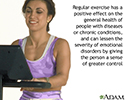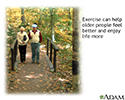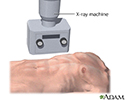Multimedia Gallery
Sciatica
Sciatica. It's not a new trendy restaurant in New York or LA, or a new SciFi program on your favorite cable channel. Sciatica is something much less sexy. Sciatica might actually be the cause of that the sharp pain you occasionally feel in your backside, or traveling down your hip or leg. What is sciatica? What does this pain mean?
Sciatica occurs when there is pressure or damage to the Sciatic nerve. This large nerve starts in your lower spine and runs down the back of each leg. It controls the muscles of the back of your knee and lower leg. It also provides sensation to the back of your thigh, part of your lower leg, and the sole of your foot.
Sciatica is usually caused by another problem, such as a slipped disk, spinal stenosis or narrowing of the spinal column, piriformis syndrome, the narrowing of muscle in your buttocks, a pelvic injury or fracture, and perhaps even tumors.
Your pain may feel like a mild tingling, a dull ache, or a burning sensation. Sometimes the pain can be so bad you might not be able to move. The pain will usually occur on one side, perhaps as a sharp pain in one part of your hip or leg, or maybe you will notice the numbness. The pain may get worse after you stand or sit, at night, when you sneeze, cough, or laugh, or when you bend backwards or walk forward.
For treatment, your doctor will perform a careful physical exam. Your doctor might find you have weakness when you bend your knee or move your foot, trouble bending your foot inward or downward, weak reflexes, or pain when you lift your leg straight up off the examination table while lying down.
Your doctor may also do other tests to find what's causing your sciatica, including blood tests, x-rays, and other imaging tests.
Treatment will focus on what causes your sciatica. Sometimes you may not need treatment because your pain will go away on its own. Your doctor will likely first recommend that you take steps to calm your symptoms and reduce inflammation, such as applying heat or ice to the painful area. You might try ice for the first 48 to 72 hours after you feel pain, then use heat afterwards. Your doctor might also tell you to take over-the-counter pain relievers.
If conservative measures don't help your problem, your doctor may recommend you have injections to reduce inflammation around your sciatic nerve and other medicines to reduce the stabbing pain. Physical therapy may be a viable option, so talk to your healthcare provider about this option.
Whatever you do, don't stay in bed all day. You need to reduce your normal activity for the first few days after you start having pain, but getting no activity will only make your pain worse. After a few days, try gradually returning to your normal routine. But, avoid heavy lifting or twisting your back for at least 6 weeks. Make sure you start exercising again though after 2 to 3 weeks. Remember, include exercises to strengthen your abdomen or belly and improve the flexibility of your spine.
Sciatica
Review Date: 4/1/2025
Reviewed By: Linda J. Vorvick, MD, Clinical Professor Emeritus, Department of Family Medicine, UW Medicine, School of Medicine, University of Washington, Seattle, WA. Also reviewed by David C. Dugdale, MD, Medical Director, Brenda Conaway, Editorial Director, and the A.D.A.M. Editorial team.
Animations
- Ankle ligament injury
- Ankylosing spondylitis
- Anterior shoulder stretch
- Arm reach
- Arthritis
- Bone fracture repair
- Bunion
- Carpal tunnel syndrome
- Exercise
- External rotation with band
- Fibromyalgia
- Foot pain
- Heel pain
- Herniated disk
- Herniated nucleus pulposus ...
- Hip joint replacement
- How to use a pill cutter
- Internal rotation with band
- Isometric
- Knee joint replacement
- Multiple sclerosis
- Neck pain
- Osteoarthritis
- Osteoarthritis
- Osteoporosis
- Osteoporosis
- Pendulum exercise
- Plantar fasciitis
- Rheumatoid arthritis
- Rotator cuff problems
- Sciatica
- Scoliosis
- Shoulder blade retraction
- Shoulder blade retraction w...
- Shoulder joint dislocation
- Shoulder pain
- Spinal stenosis
- Stretching back of your shoulder
- Up the back stretch
- Vacation health care
- Wall push-up
- Wall stretch
- What is tennis elbow?
Illustrations
- ACL degrees
- ACL injury
- Active vs. inactive muscle
- Aerobic exercise
- Ankle anatomy
- Ankle sprain
- Ankle sprain swelling
- Anterior cruciate ligament ...
- Anterior skeletal anatomy
- Arthritis in hip
- Aseptic necrosis
- Baker cyst
- Benefit of regular exercise
- Blood supply to bone
- Blood test
- Bone biopsy
- Bone density scan
- Bone graft harvest
- Bone tumor
- Bone-building exercise
- Bursa of the elbow
- Bursa of the knee
- Bursitis of the shoulder
- Calcium benefit
- Calcium source
- Calculating body frame size
- Calories and fat per serving
- Carpal biopsy
- Carpal tunnel surgical procedure
- Carpal tunnel syndrome
- Cauda equina
- Central nervous system
- Central nervous system and ...
- Cervical spondylosis
- Cervical vertebrae
- Changes in spine with age
- Chest stretch
- Chondromalacia of the patella
- Clubfoot deformity
- Colles fracture
- Common peroneal nerve dysfu...
- Compression fracture
- Compression of the median nerve
- Congenital hip dislocation
- Contracture deformity
- Corns and calluses
- CREST syndrome
- CT scan
- Damaged axillary nerve
- Dislocation of the hip
- Early treatment of injury
- Elbow - side view
- Electromyography
- Ewing sarcoma - x-ray
- Exercise - a powerful tool
- Exercise and age
- Exercise and heart rate
- Exercise can lower blood pr...
- Exercise with friends
- External fixation device
- Fast food
- Femoral fracture
- Femoral nerve damage
- Fibromyalgia
- Fish in diet
- Foot swelling
- Forward bend test
- Fracture types (1)
- Fracture types (2)
- Fracture, forearm - x-ray
- Fractures across a growth plate
- Groin stretch
- Hammer toe
- Hamstring stretch
- Head trauma
- Healthy diet
- Herniated disk repair
- Herniated lumbar disk
- Herniated nucleus pulposus
- Hip fracture
- Hip stretch
- Hunger center in brain
- Hypermobile joints
- Impingement syndrome
- Inflamed Achilles tendon
- Inflamed shoulder tendons
- Internal fixation devices
- Intervertebral disk
- Isometric exercise
- Joint aspiration
- Knee arthroscopy
- Knee joint
- Knee joint replacement pros...
- Knee pain
- Kyphosis
- Lateral collateral ligament
- Lateral collateral ligament...
- Lateral collateral ligament pain
- Leg pain (Osgood-Schlatter)
- Leg skeletal anatomy
- Limited range of motion
- Location of whiplash pain
- Lordosis
- Lower leg edema
- Lower leg muscles
- Lower leg muscles
- Lumbar vertebrae
- Lupus - discoid on a child'...
- Lupus - discoid on the face
- Lupus, discoid - view of l...
- Medial collateral ligament
- Medial collateral ligament ...
- Medial collateral ligament pain
- Meniscal tears
- Metatarsus adductus
- MRI scans
- Muscle biopsy
- Muscle cells vs. fat cells
- Muscle pain
- Muscle strain
- Muscular atrophy
- myPlate
- Neck pain
- Nerve biopsy
- Nerve conduction test
- Normal foot x-ray
- Normal knee anatomy
- Nuclear scan
- Osteoarthritis
- Osteoarthritis
- Osteoarthritis vs. rheumato...
- Osteogenic sarcoma - x-ray
- Osteomyelitis
- Osteoporosis
- Osteoporosis
- Patellar dislocation
- Physical activity - prevent...
- Plantar fascia
- Plantar fasciitis
- Posterior cruciate ligament...
- Posterior spinal anatomy
- Psoriasis - guttate on the ...
- Psoriasis - guttate on the cheek
- Radial head injury
- Radial nerve dysfunction
- Raynaud's phenomenon
- Reactive arthritis - view o...
- Retrocalcaneal bursitis
- Rheumatoid arthritis
- Rheumatoid arthritis
- Rheumatoid arthritis
- Rheumatoid arthritis
- Rotator cuff muscles
- Runners knee
- Sacrum
- Sciatic nerve
- Sciatic nerve damage
- Sclerodactyly
- Scoliosis
- Scoliosis
- Scoliosis brace
- Shin splints
- Shoulder arthroscopy
- Shoulder joint
- Shoulder joint inflammation
- Shoulder sling
- Signs of scoliosis
- Skeletal spine
- Skeleton
- Smashed fingers
- Spinal anatomy
- Spinal cord injury
- Spinal curves
- Spinal fusion
- Spinal stenosis
- Spinal stenosis
- Spinal tumor
- Spine supporting structures
- Sprained ankle
- Superficial anterior muscles
- Surface anatomy - normal palm
- Surface anatomy - normal wrist
- Synovial biopsy
- Synovial fluid
- Systemic lupus erythematosus
- Systemic lupus erythematosu...
- Tailbone (coccyx)
- Telangiectasia
- Tendinitis
- Tendon vs. ligament
- Tendonitis
- Tendons and muscles
- The structure of a joint
- Thigh stretch
- Tibial nerve
- Tophi gout in hand
- Torn lateral collateral ligament
- Torn medial collateral ligament
- Torticollis (wry neck)
- Treatment for leg strain
- Triangular shoulder sling
- Triceps stretch
- Ulnar nerve damage
- Uric acid crystals
- Vertebra, cervical (neck)
- Vertebra, lumbar (low back)
- Vertebra, thoracic (mid back)
- Vertebrae
- Vertebral column
- Vitamin D source
- Weight loss
- Whiplash
- Wrist anatomy
- Wrist splint
- X-ray
- X-ray
- Yo-yo dieting
Presentations
- Ankle sprain - Series
- Anterior cruciate ligament ...
- Bone fracture repair - series
- Bunion removal - series
- Carpal tunnel repair - series
- Clubfoot repair - series
- Creating a sling - series
- Hand splint - series
- Hip joint replacement - series
- Knee arthroscopy - series
- Knee joint replacement - series
- Leg lengthening - series
- Lumbar spinal surgery - series
- Microdiskectomy - series
- Partial knee replacement - ...
- Rotator cuff repair - series
- Shoulder separation - series
- Spinal bone graft - series
- Spinal fusion - series
- Spinal surgery - cervical -...
- Two person roll - series

 Bookmark
Bookmark


























































































































































































































































































